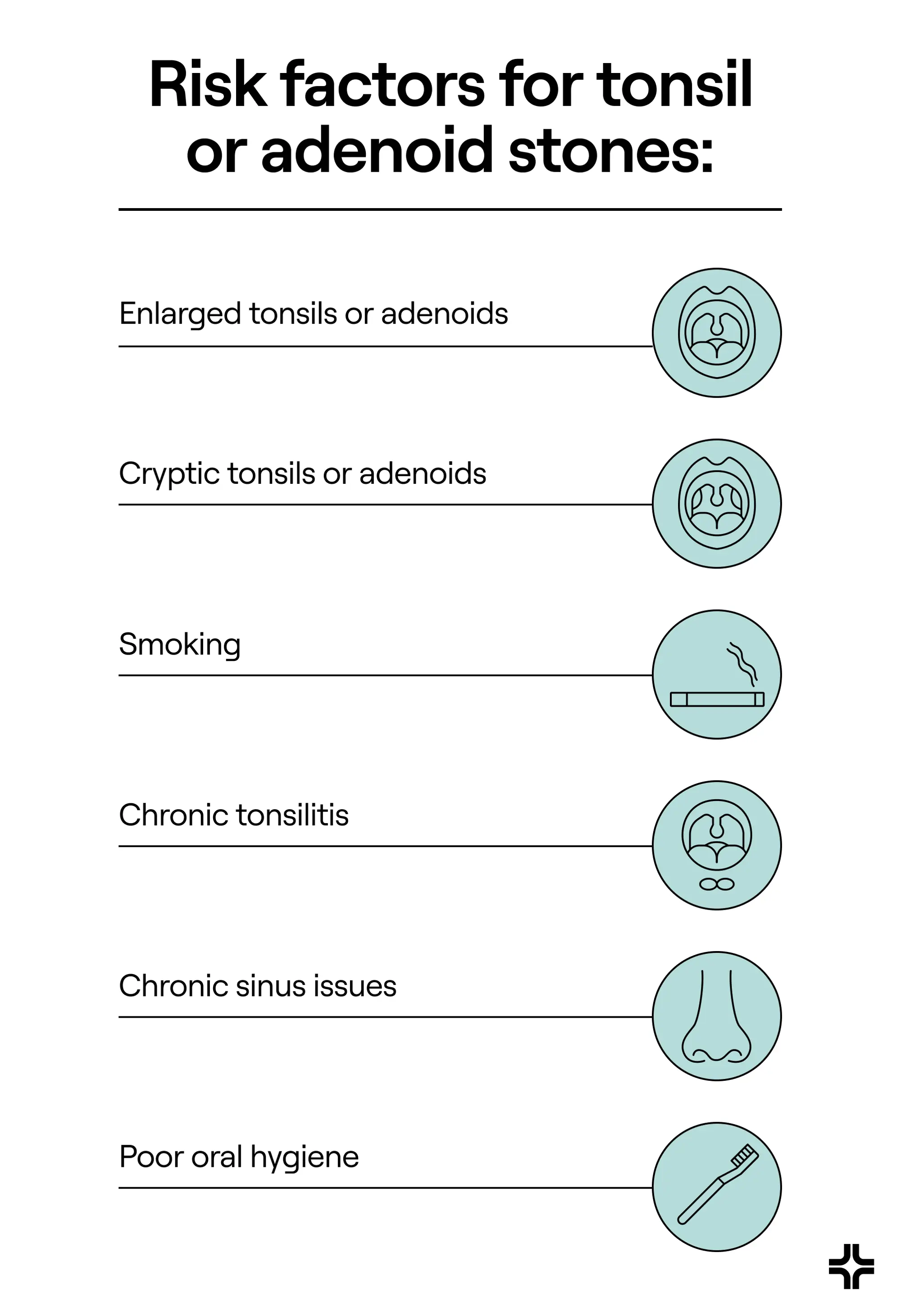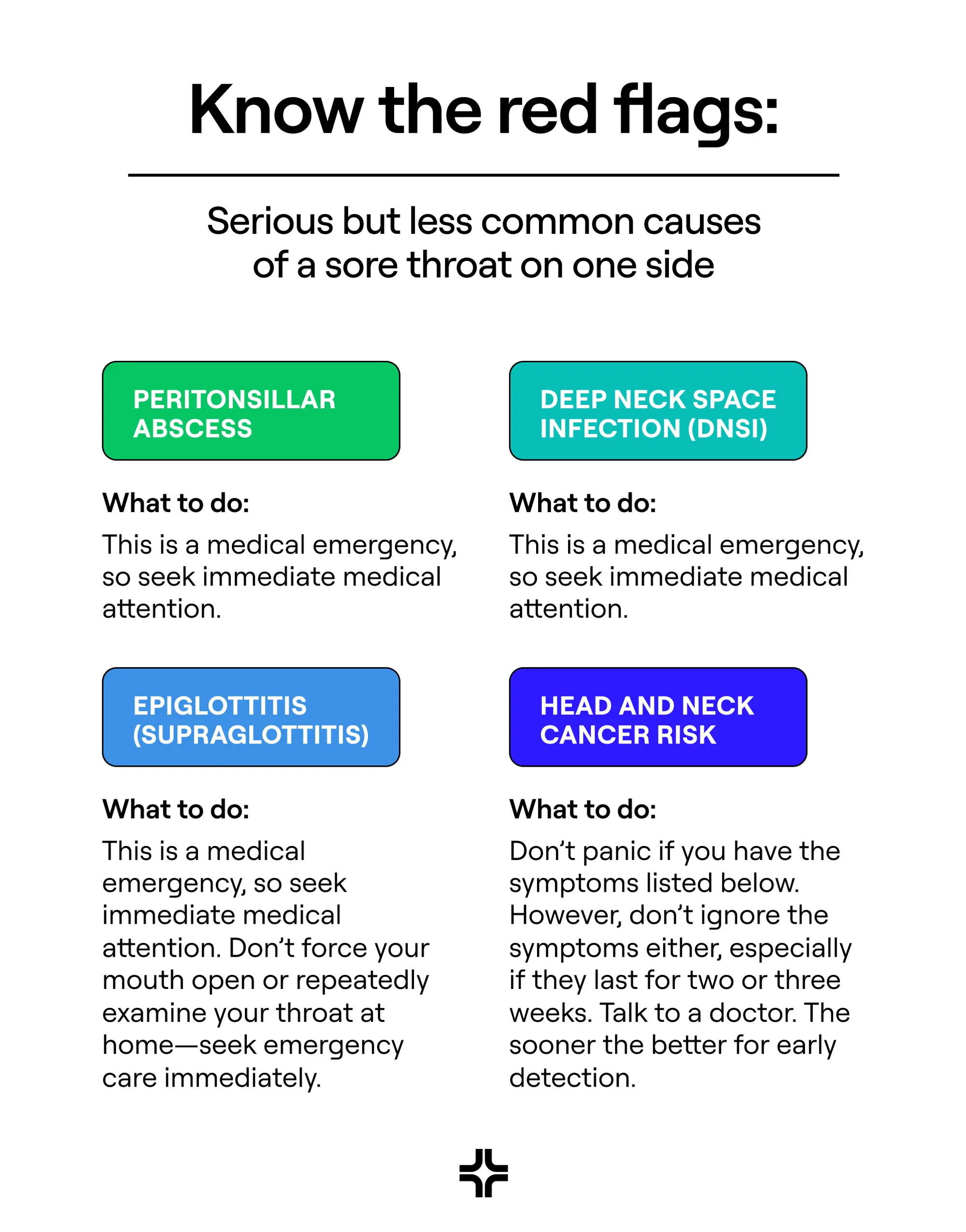
Jump to
Book a visit
$25 typical copay
$100 without insurance
Get a legitimate doctor's note online today for work or school.
Your throat serves as a first line of defense against any bad-guy germs you inhale or consume. So it can be a place where infection shows up, leaving you with a dreaded sore throat, even just on one side. But a one-sided sore throat may not be an infection at all. Your symptoms may point the finger at other problems, including tonsil stones, acid reflux, injury, and more.
Nearly every person on the planet has probably experienced this moment. You wake up and notice that your throat hurts on one side, especially when you swallow. Are you sick?
You drag yourself to the bathroom mirror, open up and say ahhh, and use that trusty flashlight on your smartphone (so many uses for that thing!) to peer into your mouth and inspect for any redness or the dreaded white spots that often signal an infection, such as strep throat.
In truth, many things can cause a sore throat on one side, from tonsillitis to post-nasal drip and even tonsil stones. Yep, your tonsils can get stones if they become “cryptic.” Sounds spooky, right. (How cryptic of us, but you can read on to find out what that even means.)
Throat pain on one side is one of those things that can be a mystery, but talking to a provider can help you get to the bottom of your asymmetrical symptoms and feeling better fast.
In this article, we’ll explore common causes of one-sided sore throat, why your throat hurts when you swallow, when to see a medical professional, and treatment options for feeling better.
What does “sore throat on one side” mean?
Getting down to basics, if one side of your throat hurts, it is really about inflammation, your immune system doing its thing to address some issue. The big question is: What’s causing the inflammation?
“A sore throat on one side is pretty common and is usually due to local infection or irritation, especially tonsillitis, pharyngitis, or post-nasal drip,” says Elizabeth Rubin, MD, the clinical advisor for Embers Recovery.
We’ll explore those possibilities and more in the next section, but you may encounter other symptoms beyond just one-sided throat pain.
Potential additional symptoms:
- Pain that radiates to the ear or jaw on the same side
- Painful swallowing
- Swollen tonsil on one side or both
- Swollen uvula (that fleshy thing that dangles from your mouth roof)
- Neck tenderness or swelling
- Bad breath
- Fever or chills
- Body aches
Common causes of a one-sided sore throat
Now let’s get to the heart of the mystery. What’s causing your one-sided sore throat? Is your left tonsil launching a full-scale rebellion? Did you eat one of those mythical razor blades in your Halloween candy and it’s lodged in your right tonsil? It sure can feel like that.
But all kidding aside, this section contains some common possibilities. But first, we need a quick throat anatomy lesson about the structures that are all up in there.
- Tonsils are glands made of lymphoid tissue, where lymphocytes (a type of white blood cell) form. The tonsils serve as your first line of defense against inhaled or ingested pathogens (germs). In other words, your tonsils can help protect the rest of your body.
- Adenoids are another set of glands made of lymphoid tissue that affect the back of your throat. These are in the nasopharynx, the upper part of the throat above the roof of your mouth and behind your nasal cavity. They act as a filter for pathogens coming from your nose.
- Uvula, a fleshy structure that dangles from your mouth roof in front of your throat.
Viral or bacterial pharyngitis, tonsillitis, adenoiditis
That’s a lot of “itises” so let’s break ’em down.
- Pharyngitis serves as an umbrella term for inflammation in the back of the throat.
- Tonsillitis is a type of pharyngitis that involves inflammation of one or both tonsils.
- Adenoiditis, inflammation of the adenoids, although not a type of pharyngitis, can commonly occur with pharyngitis or tonsillitis.
Viruses and bacteria can infect the back of the throat or the tonsils, adenoids, or all these tissues.
Potential treatment(s): If testing confirms a bacterial infection, your clinician may prescribe antibiotics; if a virus is the culprit, it won’t benefit from antibiotics, so your provider will find other ways to help you manage your symptoms.
Tonsil stones or adenoid stones (Tonsilloliths or adenoliths)
If you’ve never heard of tonsilloliths (tonsil stones) or adenoliths (adenoid stones) before, buckle up for a crash course. You can get stones in your tonsils or your adenoids. These stones are hardened masses of bacteria, mucus, and cellular or even food debris that get caught. Although tonsil stones are common, reports of adenoid stones are rare and aren’t widely described in standard research.
You can typically see tonsilloliths by peering into the back of your throat with a light, but you won’t be able to see adenoliths, since you can’t see your adenoids. Sometimes these stones dislodge, however, and you might feel as if you have to spit something out.
They often smell terrible because of their volatile sulfur compounds, so if you extract a white glob that smells somewhat rotten, that’s a good clue you’ve got stones sticking around.
Symptoms:
- Small yellow, white, or gray deposits on your tonsils
- Bad breath
- Sore throat on one or both sides
- Ear pain
- Pain with or difficulty swallowing
- Feeling like something is stuck in your throat
- Chronic tonsillitis
- Neck swelling
Now for the spooky part: You're more at risk for these stones if these tissues have become enlarged or cryptic, meaning they have a pitted look or crevices. (Picture the surface of the moon.) Larger tonsils and adenoids tend to be more cryptic.
Risk factors for tonsil or adenoid stones:
- Enlarged tonsils or adenoids
- Cryptic tonsils or adenoids
- Smoking
- Chronic tonsilitis
- Chronic sinus issues
- Poor oral hygiene
Even if you’ve undergone a tonsillectomy or adenoidectomy, you may still experience these stones, especially if the surgeon left some tissue intact, you have scar tissue, or your tonsils or adenoids regrow after removal.

Risk factors for tonsil or adenoid stones
Potential treatment(s): In most cases, tonsil and adenoid stones can be treated at home. Try gargling with salt water, which may help dislodge tonsilloliths. For adenoliths, you can try a saline nasal rinse. For tonsil stones, you may also be able to dislodge them by gently using a cotton swab. If you try to remove a stone at home, do so cautiously to avoid bleeding or aspiration; professional removal is safer. Specialized non-prescription oral rinses formulated to reduce volatile sulfur compounds may help, but make sure to avoid aggressive probing. Sometimes a tonsillectomy or adenoidectomy is necessary if these areas have become too cryptic—aka, full of nooks and crannies where germs can lurk.
Postnasal drip and sinusitis
Your ears, nose, and throat are all connected, so when one of these areas has an issue, it can affect the others. Here are two related issues to consider.
- Postnasal drip: Mucus drips from your nasal passages down your throat all the time (Yum!), often without causing an issue. But sometimes these secretions become thicker or more abundant because of allergies, illness, irritants, or another factor. In these cases, you might feel the sensation of increased drainage or a tickle, and the issue may irritate your throat, on one side or across the board.
- Sinusitis: Your sinuses are the air-filled spaces within your skull around your nasal passages. They produce mucus to keep things wet and clean. Sinusitis is inflammation of your sinuses. An infection, allergies, irritants, structural issues, and underlying conditions can all cause sinusitis. The issue can thicken nasal secretions that then drain into the throat and cause irritation.
Symptoms of nasal issues affecting your throat:
- Facial pain or pressure
- Headache
- Swelling of the cheeks, forehead, or eye area
- Fever
- Bad breath
- Reduced sense of taste
- Cough
- Ear pain
- A scratchy throat
- Nausea or vomiting
- Frequent throat clearing
Potential treatment(s): Getting to the underlying cause of any sinus issues and treating them will help ease postnasal drip and sinusitis. Most sinus infections are viral and improve within seven to 10 days. Use saline rinses and (if allergies are involved) intranasal corticosteroids. Seek care for severe symptoms, “double-worsening,” or symptoms that last longer than 10 days—those may suggest a bacterial infection, for which you will need an antibiotic. Sometimes corticosteroids are required to bring down inflammation. Saline nasal rinses and gargling with warm salt water can also help thin mucus in nasal passages and the back of your throat.
Mouth and throat ulcers
Ulcers (aka canker sores) are painful sores, and they can develop anywhere in your mouth or throat, including on your tonsils.
Ulcers can occur because of infections, underlying conditions (especially autoimmune disorders), acid erosion from gastroesophageal reflux disease (GERD), trauma (such as a bitten tongue or cheek), nutritional deficiencies, and more.
A sore that’s on or near a tonsil or at the back of the tongue or throat may cause a one-sided sore throat.
Symptoms:
- Pain or burning when talking, eating, or drinking
- A white or yellow sore with a reddish border
- Swelling
- Bleeding
- Bad breath
Potential treatment(s): If you have a bacterial infection, you will need an antibiotic. Other treatments may include corticosteroids to bring down inflammation, antiseptic mouthwashes, or even topical products to ease pain, such as lidocaine.
Oral thrush
Oral thrush is an infection in the mouth that the yeast Candida causes. The infection typically presents with white or off-white patches on the tongue, cheeks, gums, etc. The patches may be flat or raised with a cottage-cheese-like texture, and the infection can cause a sore throat.
Symptoms:
- Bad breath
- Burning or pain, especially when eating or drinking
- Loss of taste
- Difficulty swallowing or speaking
- Redness or swelling
- Cracks in the corners of the mouth
You may be more at risk for oral thrush if you are immunocompromised, take corticosteroids or antibiotics, or use inhalers for asthma, chronic obstructive pulmonary disease (COPD), or another respiratory condition. Risk factors also include diabetes, dentures, dry mouth (xerostomia), HIV/immunosuppression, recent antibiotics, and using inhaled corticosteroids without rinsing afterward.
Potential treatment(s): Oral thrush requires antifungal treatments, including rinses, medications, or gels. Your provider may also recommend changes to your oral hygiene routine, such as preventive rinses, that help reduce the risk of future infections.
Dental causes
Sure, no one loves to go to the dentist, but worsened dental health may also be behind your one-sided sore throat. Tooth abscesses and gum infections can cause referred pain that manifests as a sore throat, especially on the side of the mouth that has the issue.
Symptoms:
- Throbbing pain
- Sensitivity to hot or cold
- Swelling
- Sinus pain
- Fever
- Pus
- Bad breath
- Bad taste in mouth
- Difficulty chewing or swallowing
- Neck swelling
Potential treatment(s): Treating the underlying dental issues will help resolve your one-sided sore throat. Options may include antibiotics, tooth extraction, cavity fillings, and more.
Irritants or minor trauma
We put our mouths through a lot in a day, from inhaling what’s around us to eating and drinking—all of which can cause irritation. If you’re exposed to wildfire smoke or other pollution, you may experience nasal or throat passage issues. Other potential throat irritants include tobacco or vape smoke, alcohol, spicy foods, and more.
Additionally, if you’ve ever screamed at a concert (Lookin’ at you, Swifties!) or had to yell to talk to your friend at, say, a loud bar, you may have subjected your throat to a little trauma. Typically, the issue will resolve in a day or so, provided you give those pipes a break. Snoring or mouth breathing can also be a common sore-throat culprit.
Potential treatment(s): Avoiding the irritant or source of trauma will help resolve your sore throat. If you snore or breath through your mouth, talk to your provider about solutions. For short-term relief, a saltwater gargle may help.
Other potential causes to consider include STIs, viral infections such as EBV (mono), influenza, and COVID-19, which can all present with one-sided throat pain. Even a foreign body (e.g., a tiny lodged fish bone after eating) can cause localized pain to one side.
Gastroesophageal reflux disease (GERD)
GERD is a chronic gastrointestinal (GI) condition that shows up as frequent problems with acid reflux, which is when the contents of your stomach backflow into your esophagus, aka your “food pipe.” Reflux often causes heartburn—a burning sensation in the chest or throat—as a symptom.
The lower esophageal sphincter, a valve separating your esophagus from your stomach, should manage the flow of food and drink through your upper GI tract. But sometimes it messes up, leading to reflux, which can irritate your throat, including on one side.
Symptoms:
- Coughing
- Difficulty swallowing
- Heartburn
- Lump in the back of the throat
- Regurgitation of food or liquid
- Asthma exacerbations
- Bad taste in mouth
- Chest pain
- Dental erosions
- Laryngitis or hoarseness
- Nausea or vomiting
- Stomach pain
- Wheezing
Potential treatment(s): Managing GERD will help relieve your sore throat. Your provider may recommend over-the-counter or prescription medications to control acid reflux. Dietary changes may also help. These include avoiding any trigger foods that tend to worsen your GERD symptoms.
TMJ or neck muscle strain
Temporomandibular joint (TMJ) issues and muscle strains or compression can also cause a sore throat. All these things can irritate a nerve, cause a joint misalignment, or even lead to inflammation, presenting as throat pain.
“It only takes 10 degrees of head tilt during sleep to compress the side tissues of your throat unevenly,” says Elizabeth Moffett, RRT, a registered respiratory therapist and a respiratory wellness advocate and expert advisor for Omhale.
Potential treatment(s): Treating the underlying source of your jaw issues or muscle strain will help ease your sore throat. If you have TMJ that’s worsened by grinding your teeth or clenching your jaw at night, a mouth guard might help, for example. Likewise, using a pillow that reduces neck strain may help.
Serious but less common causes (know the red flags)
The medical conditions in this section are less common causes of a sore throat on one side, but they are serious and require more urgent medical attention, with some being outright medical emergencies, meaning drop everything right now and get thee to a doctor.
Treatments for these issues will be somewhat individual, but may include surgical procedures, antibiotics, anti-inflammatory medications, corticosteroids, or other prescriptions.

Serious causes of a sore throat on one side
Peritonsillar abscess
A peritonsillar abscess (aka quinsy) occurs when pus collects, as a result of bacteria, in the space between one tonsil and the back of the throat.
🚩 What to do: This is a medical emergency, so seek immediate medical attention.
Risk factors:
- History of tonsillitis
- Smoking
- Weakened immune system
Symptoms:
- Severe sore throat (generally on one side)
- Difficulty or pain when swallowing
- Uvula deviation (the uvula leans to one side)
- Fever
- Headache
- Ear pain
- Bad breath
- Swelling
- “Hot potato voice,” thick, muffled speech
- Breathing problems if significant swelling
Typical management includes needle aspiration or incision and drainage, along with antibiotics and pain control.
Deep neck space infection (DNSI)
A deep neck space infection (DNSI) is a bacterial infection in the tissues of the neck, including muscles, fascia, and lymph nodes.
🚩 What to do: This is a medical emergency, so seek immediate medical attention.
Risk factors:
- Dental infections
- Tonsillitis
- Salivary gland infection
- Neck trauma
Symptoms:
- Neck pain or stiffness
- Fever
- Neck swelling
- Difficulty swallowing
- Breathing issues
- Hoarse voice
- Fatigue or feeling unwell
Airway compromise is the key risk; dental infections are a common source.
Epiglottitis (supraglottitis)
Epiglottitis, sometimes called supraglottitis, is inflammation of the epiglottis, the flap of cartilage at the back of the tongue, and its surrounding tissues, known as the supraglottic area. An infection can cause the problem, which can lead to airway obstruction.
🚩 What to do: This is a medical emergency, so seek immediate medical attention. Don’t force your mouth open or repeatedly examine your throat at home—seek emergency care immediately.
Risk factors:
- Infection (including bacterial, viral, or fungal)
- Weakened immune system
- Throat injury
- Smoking or vaping
Symptoms:
- Sudden and severe throat pain
- Fever
- Trouble breathing
- Difficulty swallowing, which may lead to drooling saliva
- Stridor: a high-pitched noise when breathing in
Head and neck cancer risk
Various types of head and neck cancer can also cause a one-sided sore throat. However, the symptoms associated with head and neck cancer mimic lots of other conditions, including a cold or the flu.
🚩 What to do: Don’t panic if you have the symptoms listed below. However, don’t ignore the symptoms either, especially if they last for two or three weeks. Talk to a doctor. The sooner the better for early detection.
Risk factors:
- Human papillomavirus (HPV)
- Tobacco use, including vaping
- Exposure to secondhand smoke
- Alcohol consumption
- Epstein-Barr virus (EBV)
- Weakened immune system
- Family history
- Radiation exposure
- Poor oral hygiene
- Some dietary factors, such as chewing areca nuts and regularly eating salt-cured meat and fish
Symptoms:
- Persistent sore throat
- Persistent or frequent ear pain or infections
- Frequent headaches
- Facial pain
- Neck pain
- Difficulty or discomfort when swallowing or chewing
- Voice changes
- Trouble breathing or talking (a medical emergency)
- Sensation of a lump in your throat
- Unexplained swelling
- A mouth sore that doesn’t heal
- White patches in the mouth
Why does one side of my throat hurt when I swallow
“Odynophagia (painful swallowing) occurs because swallowing presses inflamed tissue together, mechanically worsening irritation,” says Steven Goldberg, MD, the chief medical officer at Health TrackRx and a family medicine and urgent care physician at UofLHealth in Louisville, Kentucky.
“Inflammatory mediators sensitize pain fibers, amplifying pain signals,” he adds. “Swallowing rubs an already-irritated surface—like bending a bruised knuckle—so the pain spikes even though the infection isn’t necessarily worse.”
At-home care (short-term relief)
If you’re experiencing a sore throat on one side that’s not severe, you can adopt a wait-and-see approach. You can take a few steps at home to ease that sensation of swallowing nails. Dr. Goldberg recommends the following:
- Take an over-the-counter pain reliever: Ibuprofen or acetaminophen can alleviate pain and counteract a fever.
- Soothe: You can use honey in tea, warm water, or on its own in anyone over one year of age to ease irritation.
- Gargle: Gargling with warm salt water helps remove debris (including tonsil stones), thin mucus, calm irritation, and promote healing.
For children and teens, avoid aspirin as it adds a risk of Reye syndrome. Instead, use age-appropriate dosing for acetaminophen or ibuprofen.
When to seek medical care
Dr. Goldberg recommends seeking immediate care for a sore throat if you have:
- Severe one-sided pain with jaw and muscle soreness
- A muffled voice
- Uvula deviation (uvula leans to one side)
- Trouble breathing
- Inability or trouble swallowing saliva, leading to drooling
- High fever
“See a doctor if symptoms don’t improve after several days, worsen, or are accompanied by a rash or dehydration,” Dr. Goldberg adds. “Children with a sudden onset of sore throat, fever, swollen lymph nodes, and no cough should be tested for a bacterial throat infection.”
“Immediate and affordable care! That makes a big difference. From scheduling the appointment to the follow up after my visit, the service is excellent!” —Tamika, in Texas
How clinicians diagnose the cause
When you talk to a doctor, they may do the following to get to the underlying cause of your ailing throat:
- Ask about your lifestyle and medical history: This helps them determine any risk factors that could be contributing to your discomfort.
- Ask about your symptoms: This helps your provider understand what you’re going through and determine any necessary diagnostic tests.
- Perform a physical or visual exam: They may assess your neck for any swelling and look in your nose, mouth, and ears.
- Perform a throat swab culture: This is when a provider uses a long cotton swab to sample the microorganisms at the back of your throat or on your tonsils and then examines the sample under a microscope.
- Do a rapid strep test (RADT) when appropriate; in some cases, a throat culture is used to confirm the results.
Key Takeaways
- Sometimes your throat hurts on just one side—simply because the inflammation is affecting just one area.
- Common causes include infection, tonsil stones, nasal issues, acid reflux, and throat injury.
- Treatments vary, but may include medications, rinses, treating nasal conditions, and more.
- Need to talk to a provider as soon as possible? General Medicine can help.
General Medicine follows a strict editorial process, including using real experts to write our articles, vetted primary sources, fact-checking, a secondary medical review, and updates as necessary. This article was medically reviewed and fact checked by Swapna Ghanta, MD, and Ecler Ercole Jaqua, MD.
FAQ
Why is my sore throat only on one side?
Having a sore throat on one side is common because sometimes the inflammation or the infection is localized to one area.
How to cure a sore throat on the right side?
The cure for a sore throat on the right side will depend on what’s causing. If you have a bacterial infection, you will need an antibiotic, for example. Other times you may be able to treat a sore throat on your own by gargling with salt water. However, if the issue persists or you experience severe symptoms, be sure to consult a clinician.
How do you treat a swollen throat gland on one side?
If you have a swollen gland, you may have inflammation or an infection affecting just one side of your throat. If the infection is bacterial, you may need an antibiotic. However, sometimes general irritation can also cause a slightly swollen gland. In these cases, you can try gargling with salt water or drinking honey in herbal tea or warm water to ease discomfort.
How to know if a sore throat is viral or bacterial?
The only way to know if a sore throat is viral or bacterial is to undergo a throat swab culture. A provider will use a long cotton swab to collect a sample of your throat secretions that they can then test for pathogens to determine if you’ve got a virus, a bacterial infection, or general irritation.
Our editorial standards
At General Medicine, we cut through the clutter to make health care clearer, faster, and easier to navigate. Every article is grounded in evidence-based research and peer-reviewed journals, reviewed by medical professionals, and written in accessible language that helps you make health decisions with confidence. We’re committed to ensuring the quality and trustworthiness of our content and editorial process by providing information that is up-to-date, accurate, and actually useful. For more details on our editorial process, see here.



